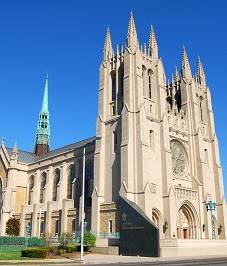
 O SING WELL IS TO PRAY TWICE. There is such musicality in the Latin original—Qui bene cantat… St. Augustine might not have said it, but he should have. If one takes the phrase “to sing well” both in a literal sense and in a spiritual sense, it then encompasses the vocation of the Christian, to praise God in the quiet of his heart and as well as in the actions of his life. It reminds me of the blessing given to cantors by decree of the Council of Carthage (c. 398AD):
O SING WELL IS TO PRAY TWICE. There is such musicality in the Latin original—Qui bene cantat… St. Augustine might not have said it, but he should have. If one takes the phrase “to sing well” both in a literal sense and in a spiritual sense, it then encompasses the vocation of the Christian, to praise God in the quiet of his heart and as well as in the actions of his life. It reminds me of the blessing given to cantors by decree of the Council of Carthage (c. 398AD):
Vide, ut quod ore cantas, corde credas, et quod corde credis, operibus comprobes
“See that what thou singest with thy lips thou dost believe in thine heart, and that what thou believest in thine heart thou dost show forth in thy works.”
To sing well is to pray twice. We have all heard the phrase bantered about by well meaning, but exasperated Christians, whether it comes from a pastor whose congregation won’t sing or a mother whose sons refuse to sway to the churchy tunes (perhaps in our secularized world most young people prefer not to pray, much less pray twice). Unfortunately the emphasis is always on the outward act of singing, with little attention given to the interior formation that must take place before the outward forms mean anything. Fortunately for the Church in America, the Archdiocese of Detroit recently announced a plan to cultivate the sweet vintage of sanctity (interior) and sacred music (exterior) via the creation of an archdiocesan choral foundation at the Cathedral of the Most Blessed Sacrament in the tradition of the English choir school. As I understand it, this is the fruition of a long held dream of Archbishop Vigneron and I firmly believe the Church in Michigan will be better for it.
Officially named the Cathedral Choir Academy of Detroit and open to students in grades 3-9, its mission is “to provide an experience in which choristers encounter Christ through sacred music, grow in faith and musical excellence, and give witness to the Word Incarnate. The program is clearly rooted in faith formation and in step with the New Evangelization.” It is hoped that within five years the program will be expanded to serve youth in the first and second grades (pre-chorister music training) through high school. Susan Lindquist, a veteran music teacher in the archdiocese of Detroit will lead the program, working in concert with Cathedral Rector Fr. J. J. Mech and Cathedral Music Director, Joe Balistreri. I have been privileged to know Susan for a couple of years and can testify to her orthodox faith and love for sacred music as well as her ability to teach children and communicate the choir school’s mission and vision to others. Her enthusiasm really is quite infectious and it was through her that I learned one of my favorite phrases regarding the importance of teaching children good music… “The fact that children can make beautiful music is less significant than the fact that music can make beautiful children” (attributed to Cheryl Lavender).
* * Notes on the Cathedral Choir Academy of Detroit
Susan took over the cathedral children’s choir last year, which until then had been comprised of children primarily from the cathedral parish, and grew the program to three times its size while expecting the choristers to hold their own alongside the cathedral’s fine adult choir. In its current form, the program consists of a training choir as well as a children’s choir, which sings once a month. This allows choristers to continue singing in their own parish choirs as well as at the cathedral. By partnering with children choirs across the archdiocese the Cathedral Choir Academy hopes to share its work with individual parishes, fostering Faith and music in all the youth. Balistreri (cathedral music director) also sought out and secured a partnership between the Choir Academy and the Sistine Chapel Choir, and while the particular details of that relationship are currently being hashed out, it shows the desire of Joe Balistreri, Susan Lindquist and the entire cathedral community to foster the Church’s musical heritage to a high degree, especially in the youth, and drawing them ever more closely to Christ.
Please join your prayers to mine for the success of this new venture, perhaps even offering up a Te Deum in the fullest sense of actual participation.
Qui bene cantat bis orat.
